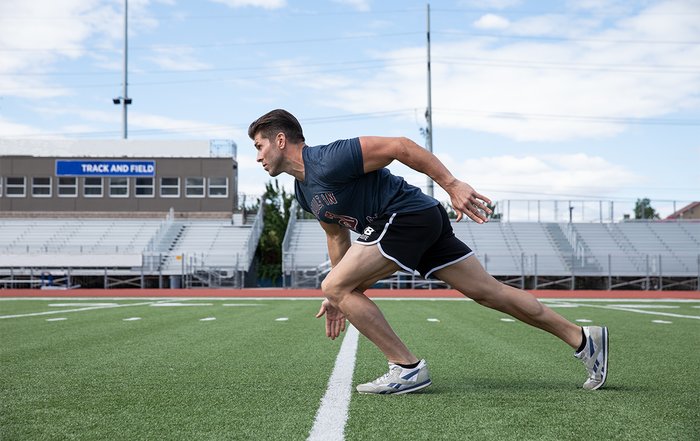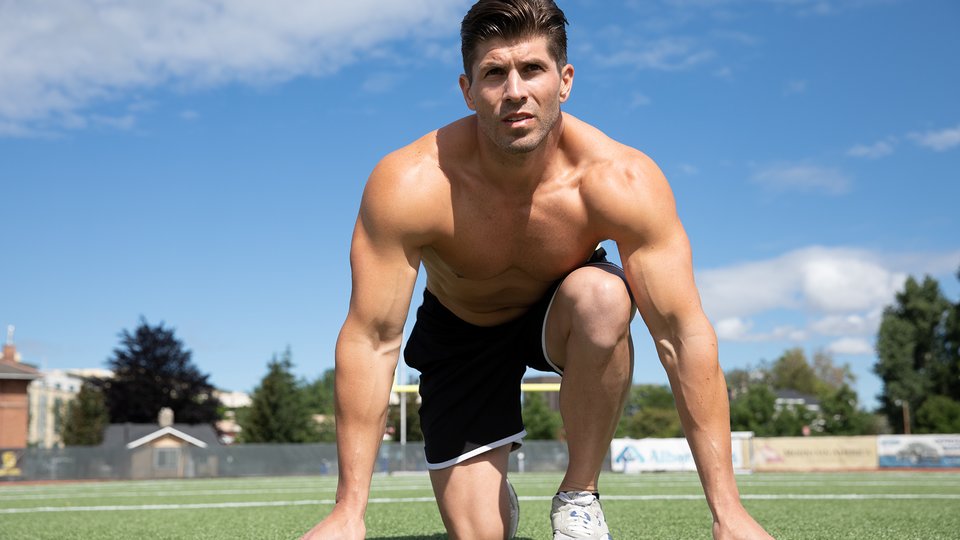Products You May Like
The gridiron is like a second home. Die-hards live for football season, and it means even more to those who are actually down on the field. Players are constantly looking for ways to gain an edge over their opponents—and one of those ways (perhaps the most important) is by improving endurance, agility, and speed.
Football is a fast-paced sport, and the better you can navigate the field, the more of a threat you are. Coaches drool over athleticism. And let’s be real—the slowest and least skillful with their feet are gonna be the first to get tackled.
But do you take the time to run the routes, the sprints, and do the recovery work on your own? It doesn’t matter when or where you do it, just as long as you do, and tight end Jerome Cunningham prefers to get in shape and sharpen his game under the sun.
“I lean more toward a beach workout when there are sunny days because it’s tougher to run on sand than the ground or grass,” says the 6-foot-3, 250-pounder, who has played for the New York Giants and Detroit Lions. “It’s also less taxing on the joints. There are so many benefits from running on the sand, especially for your leg muscles and foot muscles.”
Give Cunningham a 75-degree day, and he’s hitting the sand for sure. If you don’t live near a beach, or the weather has already turned on you, don’t worry—that won’t excuse you from this workout. A grass field or indoor turf works just as well, especially if these football drills are new to you. Complete this workout once a week to see the benefits carry over into your football performance.
Equipment you’ll need for this workout:
- Cones or some object to mark distances
- Band or hip circle for glute work
- Sled and weights (optional, skill-level dependent)
Warm-up
“Since it’s hard to find solid spots on the beach, I recommend foam rolling at home or on a nice grassy area if you can find one nearby,” says Cunningham. “When foam rolling, aim to hit all the main areas: hamstrings, quads, glutes, upper and lower back.”
After rolling out, set two cones about 60 yards apart and do some light jogging back and forth. Do it 10 times for a total of around 600 yards.
“We’ll follow this up with some band work to ensure the posterior chain is ready to go and a dynamic warm-up,” he says. “Your hips, glutes, and hamstrings will play a huge role in this workout, so we will focus on those areas.”

Band Work
- Monster walk 4 sets of 15 yards
- Lateral band walk 4 sets of 15 yards (band around the knees)
- Knee raise 4 sets of 10 reps per leg (band around the feet)
Dynamic Warm-up
- High knees 2 sets of 20 yards
- Butt kick 2 sets of 20 yards
- A-skip 2 sets of 20 yards
- B-skip 2 sets of 20 yards
- Lateral lunge 2 sets of 20 yards
- Hamstring scoop 2 sets of 20 yards
- Walking quad stretch 2 sets of 20 yards
- Sumo squat to stand 1 set of 10 reps
- Ankle jump 2 sets of 10 reps

“After I complete a dynamic warm-up, I go into sprint buildups because the majority of the workouts I do are speed related,” Cunningham explains. “I want to make sure my body is ready for the high-speed sprinting and the intensity of the agility drills.”
Sprint Buildups
- 2 sets of 10-yard sprints at 50% of max speed
- 2 sets of 20-yard sprints at 75% of max speed
- 2 sets of 30-yard sprints at 85-90% of max speed
Jerome’s Beach Workout for Football Performance
With the warm-up now complete, Cunningham usually hits agility first during his workouts. Occasionally, this changes and he’ll switch the agility and the main sprint work to give his body a little mix-up.
His agility work is split into two parts: cone drills and running sport-specific football routes.
Agility: Cone Drills
- T cone drill 6x
- 5-10-5 drill 6x
- Box drill 6x
- L drill 6x
Agility: Football Routes
If you’re a veteran, you’re likely familiar with the following terms. If you’re new or looking for something new to benefit you in another sport, the routes are explained here.
- Slant 4x left and 4x right
- Out 4x left and 4x right
- Go 4x left and 4x right
- Post 4x left and 4x right
Sprint Work
4 rounds of eight 60-yard sprints with weighted sled, rest 2 min. between sets
Cunningham recommends that anyone who hasn’t used a sled before—especially if you’re doing it on the sand—start with body weight and work up to adding weight.
Notes on sprinting:
- Don’t worry about timing the sprints—just the rest times.
- The rest intervals should be 1-2 minutes. Drop 5-10 seconds every week.
- Start off with one set of eight 60-yard sprints if you’re a beginner.
- After about two weeks, work up to 1.5 rounds of eight sprints; so one set of eight and one set of four 60-yard sprints for a total of 12 sprints.
- Continue to add around two sprints every week until you reach four rounds of eight as prescribed.

Cool-down
You’ve run your heart out, now it’s time for a cool-down!
“I wait around 3 minutes, or whenever my heart rate comes down, then take a light jog back and forth for about 60 yards, like I did in the warm-up,” Cunningham says. “This should be extremely light, close to a walking pace.”
Finish the workout by stretching your glutes, hamstrings, calves, groin, and quad muscles—recovery is just as important as the workout itself—so you can come back hard for the remainder of your workouts that week.
The game of football is rough and tumble, to say the least, so never neglect taking care of your body when you’re off the field—or in this case, the sand!
The sport of football requires an all-around package of speed, strength, and conditioning for dominant performance. Looking for a program to help you accomplish it all? Check out True Muscle: 9 Weeks to Elite Fitness with expert trainer Nick Tumminello and former NFL player Steve Weatherford. Available only on BodyFit by Bodybuilding.com.
